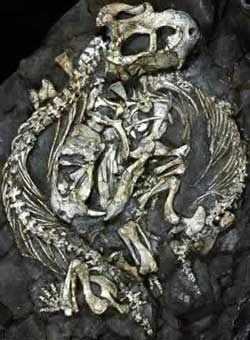Prehistoric tusks point to earliest fossil evidence of differences between sexes

Image: R. Reisz
Findings point to complex social behaviour
The large tusks of an animal that roamed Earth before the dinosaurs may provide the earliest evidence yet of male-female distinctions in land animals that existed millions of years ago, say U of T scientists.
Robert Reisz, a biology professor at the University of Toronto at Mississauga, and his team have found convincing evidence of sexual dimorphism – different physical traits between the sexes of the same species – in their study of fossils from between 252 to 260 million years ago. They believe that the male Diictodon, a herbivorous barrel-shaped creature, had two large tusks extending down from the upper jaw. The tusks, Reisz says, were used as weapons, possibly for ritualistic or physical combat.
“Our findings give very clear evidence of complex social behaviour,” Reisz says. “To see this kind of behaviour [physical combat] early in the history of the group that eventually gave rise to mammals is really quite startling.”
Reisz’s study, which is featured on the cover of the January issue of the Proceedings of the Royal Society of London B, was based on detailed studies of nearly a hundred skeletons unearthed in South Africa over the last two decades.
Diictodon appeared during the Late Permian Period of the Paleozoic Era, at least 30 million years before dinosaurs existed. It was part of a group of animals described as mammal-like reptiles and was an evolutionary relative of the animals that evolved into mammals. Diictodon, which was covered in scales and measured about one metre in length, was a burrowing herbivore with a beaked skull and short tail.
In its investigation, the team was able to rule out other uses for the tusks, Reisz says. The tusks were not used for feeding because the females did not have them nor were they used for digging because the ends did not show signs of wear. It appears the tusks became longer, wider and thicker as the animals aged and extended well below the jaw line; those lost, possibly in combat, were never replaced, Reisz says. “All these factors are very strong indicators of armament.”
Reisz says these findings go beyond the standard skeletal descriptions that accompany research on fossils. “This is a wonderful opportunity to study the biology of animals that lived so long ago. Rather than just simply looking at them and describing them, we can do more with their lifestyle, with their feeding habits, and with their general biology than just looking at their skeletons would suggest.”
Along with Reisz, the study involved Corwin Sullivan, now a graduate student at Harvard University, and Dr. Roger M.H. Smith of the South African Museum in Cape Town, South Africa. The research was funded by the Natural Sciences and Engineering Council of Canada and by the American Museum of Natural History.
Nicolle Wahl is a news services officer with the department of public affairs.
CONTACT:
U of T Public Affairs, ph: (416) 978-6974; email: nicolle.wahl@utoronto.ca
Media Contact
More Information:
http://www.newsandevents.utoronto.ca/bin4/030123b.aspAll latest news from the category: Life Sciences and Chemistry
Articles and reports from the Life Sciences and chemistry area deal with applied and basic research into modern biology, chemistry and human medicine.
Valuable information can be found on a range of life sciences fields including bacteriology, biochemistry, bionics, bioinformatics, biophysics, biotechnology, genetics, geobotany, human biology, marine biology, microbiology, molecular biology, cellular biology, zoology, bioinorganic chemistry, microchemistry and environmental chemistry.
Newest articles

Durable, Efficient, Sustainable: The Rise of Cerium Oxide Thermal Switches
Groundbreaking cerium oxide-based thermal switches achieve remarkable performance, transforming heat flow control with sustainable and efficient technology. Cerium Oxide-Based Thermal Switches Revolutionize Heat Flow Control Thermal switches, which electrically control…

How Industrial Robots are Reducing Emissions in Global Manufacturing
A new study explores the intersection of industrial automation and environmental sustainability, focusing on the role of industrial robots in reducing the carbon intensity of manufacturing exports. The research demonstrates…

Patients Can Heal Through Precise, Personalized Bioceramic Grafts
A recent review is transforming the landscape of craniomaxillofacial bone regeneration with the introduction of personalized bioceramic grafts. This pioneering research explores the fabrication and clinical potential of synthetic grafts…



